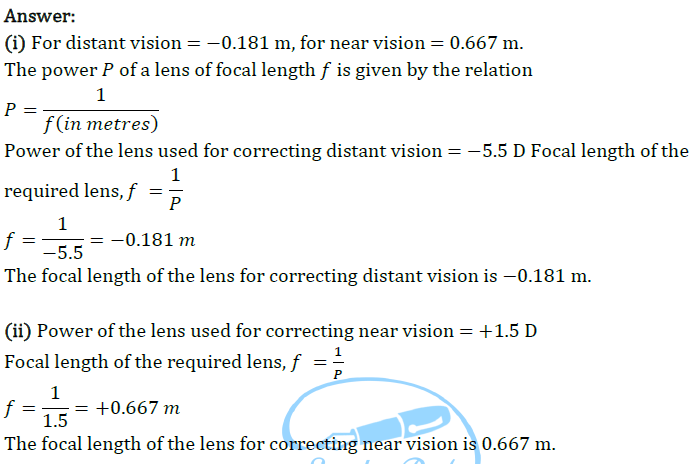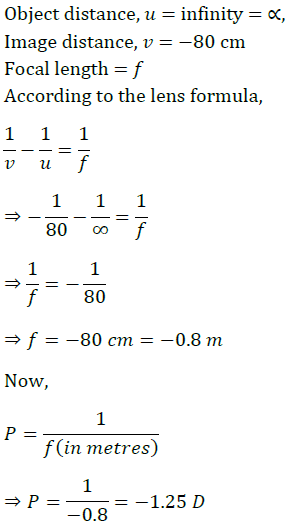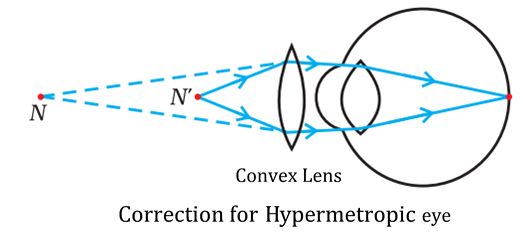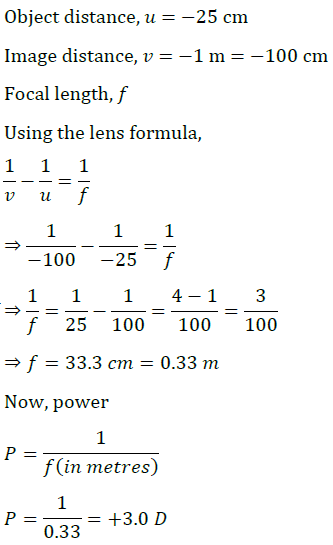NCERT Solutions for Class 10 Science Chapter 11 The Human Eye and The Colourful World
The Class 10 NCERT Solutions for Science Chapter 11 The Human Eye and The Colourful World includes all the intext and exercise questions. Class 10 Science Chapter 11 The Human Eye and The Colourful World NCERT questions and answers help students to clear their doubts and to obtain good marks in Class 10 board exam. All the solutions provided in this article are strictly based on the CBSE syllabus and curriculum.
Class 10 Science Chapter 11 NCERT Questions and Answers
Class 10 Science Chapter 11 The Human Eye and The Colourful World NCERT Questions and Answers are prepared by experts with a detailed explanation that will help students complete their assignments & homework. Having a good grasp over CBSE NCERT Solutions for Class 10 Science will further help the students in their preparation for board exams and other competitive exams such as NTSE, Olympiad, etc.
NCERT Solutions for Class 10 Science Chapter 11 Intext Questions
Intext Question (Page No. 190)
Question 1: What is meant by power of accommodation of the eye?
Answer: The ability of the lens of the eye to adjust its focal length to clearly focus rays coming from distant as well from a near objects on the retina, is known as the power of accommodation of the eye.
Question 2: A person with a myopic eye cannot see objects beyond 1.2 m distinctly. What should be the type of the corrective lens used to restore proper vision?
Answer: The person is able to see nearby objects clearly, but he is unable to see objects beyond1.2 m. This happens because the image of an object beyond 1.2 m is formed in front of the retina and not at the retina, as shown in the given figure.

To correct this defect of vision, he must use a concave lens. The concave lens will bring the image back to the retina as shown in the given figure.

Question 3: What is the far point and near point of the human eye with normal vision?
Answer: The near point of the eye is the minimum distance of the object from the eye, which can be seen distinctly without strain. For a normal human eye, this distance is 25 cm. The far point of the eye is the maximum distance to which the eye can see the objects clearly. The far point of the normal human eye is infinity.
Question 4: A student has difficulty reading the blackboard while sitting in the last row. What could be the defect the child is suffering from? How can it be corrected?
Answer: A student has difficulty in reading the blackboard while sitting in the last row. It shows that he is unable to see distant objects clearly. He is suffering from myopia. This defect can be corrected by using a concave lens.
NCERT Solutions for Class 10 Science Chapter 11 Exercise Questions
Question 1: The human eye can focus objects at different distances by adjusting the focal length of the eye lens. This is due to
(a) presbyopia
(b) accommodation
(c) near–sightedness
(d) far–sightedness
Answer: (b) accommodation
Question 2: The human eye forms the image of an object at its
(a) cornea
(b) iris
(c) pupil
(d) retina
Answer 2: (d) retina.
Question 3: The least distance of distinct vision for a young adult with normal vision is about
(a) 25 m
(b) 2.5 cm
(c) 25 cm
(d) 2.5 m
Answer: (c) 25 cm
Question 4: The change in focal length of an eye lens is caused by the action of the
(a) pupil
(b) retina
(c) ciliary muscles
(d) iris
Answer: (c) ciliary muscles.
Question 5: A person needs a lens of power −5.5 dioptres for correcting his distant vision. For correcting his near vision he needs a lens of power +1.5 dioptre. What is the focal length of the lens required for correcting (i) distant vision, and (ii) near vision?

Question 6: The far point of a myopic person is 80 cm in front of the eye. What is the nature and power of the lens required to correct the problem?
Answer: The person is suffering from an eye defect called myopia. In this defect, the image is formed in front of the retina. Hence, a concave lens is used to correct this defect of vision.

A concave lens of power −1.25 D is required by the person to correct his defect.
Question 7: Make a diagram to show how hypermetropia is corrected. The near point of a hypermetropic eye is 1 m. What is the power of the lens required to correct this defect? Assume that the near point of the normal eye is 25 cm.
Answer: A person suffering from hypermetropia can see distinct objects clearly but faces difficulty in seeing nearby objects clearly. It happens because the eye lens focuses the incoming divergent rays beyond the retina. This defect of vision is corrected by using a convex lens. A convex lens of suitable power converges the incoming light in such a way that the image is formed on the retina, as shown in the following figure.

The convex lens actually creates a virtual image of a nearby object (N’ in the figure) at the near point of vision (N) of the person suffering from hypermetropia.
The given person will be able to clearly see the object kept at 25 cm (near point of the normal eye), if the image of the object is formed at his near point, which is given as 1 m.

A convex lens of power +3.0 D is required to correct the defect.
Question 8: Why is a normal eye not able to see clearly the objects placed closer than 25 cm?
Answer: A normal eye is not able to see the objects placed closer than 25 cm clearly because the ciliary muscles of the eyes are unable to contract beyond a certain limit.
Question 9: What happens to the image distance in the eye when we increase the distance of an object from the eye?
Answer: Since the size of eyes cannot increase or decrease, the image distance remains constant. When we increase the distance of an object from the eye, the image distance in the eye does not change. The increase in the object distance is compensated by the change in the focal length of the eye lens. The focal length of the eye changes in such a way that the image is always formed at the retina of the eye.
Question 10: Why do stars twinkle?
Answer: The twinkling of a star is due to atmospheric refraction of starlight. The starlight, on entering the earth’s atmosphere, undergoes refraction continuously before it reaches the earth. The atmospheric refraction occurs in a medium of gradually changing refractive index.
Question 11: Explain why the planets do not twinkle?
Answer: The planets are much nearer to the earth than stars and because of this they can be considered as large source of light. If a planet is considered to be a collection of a very large number of point sources of light, then the average value of change in the amount of light entering the eye from all point size light sources is zero. Due to this the effect of twinkling is nullified.
Question 12: Why does the Sun appear reddish early in the morning?
Answer: The light coming from the sun passes through various denser layers of air in the earth’s atmosphere before reaching our eyes near the horizon. Most of the part of blue light and light of small wavelength gets scattered by dust particles near the horizon. So, the light reaching our eyes is of large wavelength. Due to this the sun appears reddish at the time of sunrise and sunset.
Question 13: Why does the sky appear dark instead of blue to an astronaut?
Answer: The sky appears dark instead of blue to an astronaut because there is no atmosphere in the outer space that can scatter the sunlight. As the sunlight is not scattered, no scattered light reached the eyes of the astronauts and the sky appears black to them
Topics covered under Class 10 Science Chapter 11 The Human Eye and The Colourful World
Below we have listed the topics discussed in NCERT Solutions for Class 10 Science Chapter 9. The list gives you a quick look at the different topics and subtopics of this chapter.
| Section in NCERT Book | Topics Discussed |
|---|---|
| 11.1 | The Human Eye |
| 11.1.1 | Power of Accommodation |
| 11.2 | Defects of Vision and their Correction |
| 11.3 | Refraction of Light Through a Prism |
| 11.4 | Dispersion of White Light by a Glass Prism |
| 11.5 | Atmospheric Refraction |
| 11.6 | Scattering of Light |
| 11.6.1 | Tyndall Effect |
NCERT Solutions for Class 10 Science Chapter 11 – A Brief Discussion
Chapter Overview: We have learnt in the previous chapter about light and some of its properties. In this chapter, we shall use these ideas to study some of the optical phenomena in nature. We shall also discuss about rainbow formation, splitting of white light and blue colour of the sky. This chapter explains the human eye and the defects in the human eye and their correction.